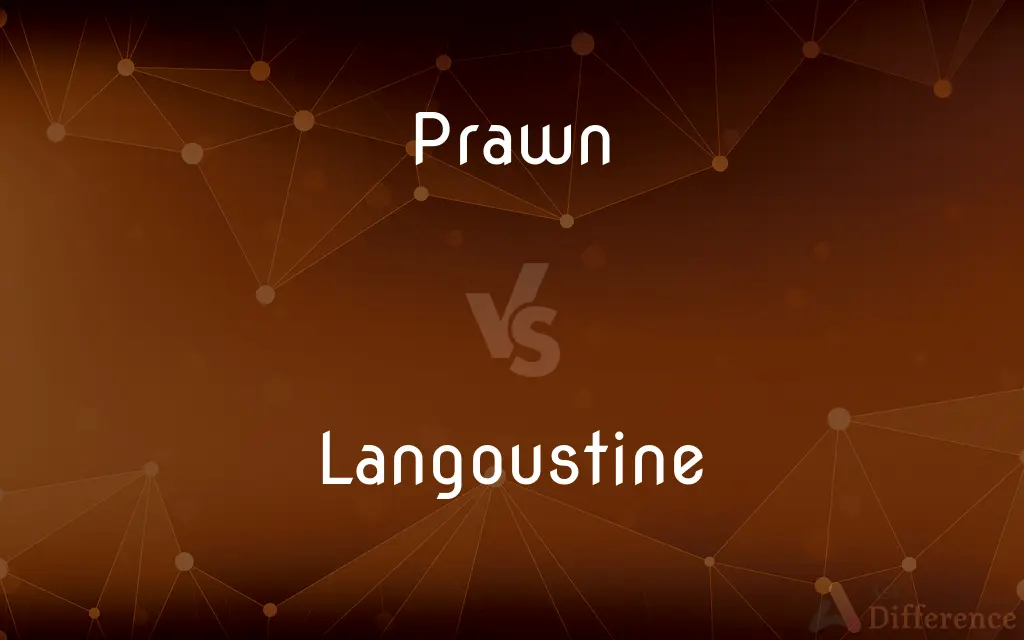Prawn vs. Langoustine — What's the Difference?
Edited by Tayyaba Rehman — By Maham Liaqat — Updated on March 28, 2024
Prawns are a common name for large swimming crustaceans found worldwide, while langoustines are a specific type of shellfish resembling small lobsters, prevalent in European waters.

Difference Between Prawn and Langoustine
Table of Contents
ADVERTISEMENT
Key Differences
Prawns are widely known for their diverse species and sizes, often found in both freshwater and marine environments. They are a popular seafood choice globally, known for their sweet, delicate flavor. Langoustines, also known as Norway lobsters (Nephrops norvegicus), inhabit the northeast Atlantic Ocean and parts of the Mediterranean Sea. They are highly prized for their firm, succulent meat and are considered a delicacy in European cuisine.
The physical appearance of prawns and langoustines differs significantly. Prawns have a more streamlined body and are equipped with claws on three pairs of their legs. Langoustines have a distinct pinkish-orange shell, a slender body, and long, narrow claws, making them resemble miniature lobsters more than they do prawns.
When it comes to culinary use, both prawns and langoustines are versatile and can be prepared in various ways. However, langoustines are often served whole or as a tail meat in fine dining, reflecting their premium status and delicate taste. Prawns, being more widely available and less expensive, are used in a broad array of dishes, from casual barbecues to gourmet meals.
In terms of nutritional value, both prawns and langoustines are low in fat and high in protein. They also provide a good source of omega-3 fatty acids, vitamins, and minerals. However, langoustines may be slightly richer in certain nutrients due to their diet and natural habitat.
Comparison Chart
Scientific Name
Varied, many species
Nephrops norvegicus
ADVERTISEMENT
Habitat
Worldwide, freshwater and marine
Northeast Atlantic, Mediterranean Sea
Appearance
Streamlined body, claws on three pairs of legs
Pinkish-orange shell, slender body, narrow claws
Culinary Use
Versatile, used in various dishes
Often served whole, considered a delicacy
Nutritional Value
Low in fat, high in protein
Rich in omega-3, vitamins, and minerals
Price & Availability
More affordable, widely available
More expensive, considered premium
Compare with Definitions
Prawn
Large swimming crustaceans.
Prawns are a favorite choice in seafood dishes around the world.
Langoustine
Predominantly found in European waters.
The best langoustines are sourced from the cold, clear waters of the northeast Atlantic.
Prawn
Nutritional benefits.
Prawns are a good source of protein, vitamins, and minerals.
Langoustine
Resemble small lobsters.
Langoustines are prized for their firm, succulent meat.
Prawn
Popular in global cuisine.
Prawns are essential in dishes like paella, shrimp cocktail, and curry.
Langoustine
Higher in certain nutrients.
Langoustines are particularly rich in omega-3 fatty acids, contributing to their premium nutritional profile.
Prawn
Found in diverse environments.
Freshwater prawns and marine species offer a wide range of flavors.
Langoustine
Delicacy in European cuisine.
Langoustines are often the highlight of gourmet seafood dishes.
Prawn
Delicate flavor.
The sweet, delicate taste of prawns makes them suitable for a variety of recipes.
Langoustine
Firm and sweet meat.
The delicate flavor and texture of langoustine tail meat are celebrated in fine dining.
Prawn
Prawn is a common name for small aquatic crustaceans with an exoskeleton and ten legs (which is a member of the order decapoda), some of which can be eaten.The term "prawn" is used particularly in the United Kingdom, Ireland, and Commonwealth nations, for large swimming crustaceans or shrimp, especially those with commercial significance in the fishing industry. Shrimp that are present in this category often belong to the suborder Dendrobranchiata.
Langoustine
A small edible lobster (Nephrops norvegicus) of the eastern Atlantic Ocean and the Mediterranean Sea, having slender claws. Also called Norway lobster, scampi.
Prawn
Any of various shrimps, especially one that is large or inhabits fresh water.
Langoustine
A small edible European orange-pink lobster, Nephrops norvegicus
Prawn
The flesh of a prawn, used as food.
Langoustine
Caught in European waters; slenderer than American lobster
Prawn
To fish for prawns.
Prawn
A crustacean of the suborder Dendrobranchiata.
Prawn
(Commonwealth) A crustacean, sometimes confused with shrimp.
Prawn
Synonym of butterface: A woman with an attractive body but an unattractive face.
She's a prawn!
Prawn
A fool, an idiot.
Prawn
Alternative form of porn.
Prawn
(intransitive) To fish for prawns.
Prawn
Any one of numerous species of large shrimplike Crustacea having slender legs and long antennæ. They mostly belong to the genera Pandalus, Palæmon, Palæmonetes, and Peneus, and are much used as food. The common English prawn is Palæmon serratus.
Prawn
Any of various edible decapod crustaceans
Prawn
Shrimp-like decapod crustacean having two pairs of pincers; most are edible
Prawn
Fish for prawns
Common Curiosities
What distinguishes prawns from langoustines?
Prawns have a more varied habitat and appearance, while langoustines are specific to certain cold waters and resemble miniature lobsters.
What are the best ways to prepare prawns?
Prawns can be cooked in a variety of ways, including frying, grilling, and adding them to pasta or curry, thanks to their versatility.
Where are langoustines found?
Langoustines are found in the northeast Atlantic Ocean and parts of the Mediterranean Sea.
How should langoustines be stored before cooking?
Langoustines should be kept on ice or in the refrigerator and cooked as soon as possible to maintain their quality.
Are prawns or langoustines more expensive?
Langoustines are generally more expensive due to their delicate flavor, texture, and status as a culinary delicacy.
How do you cook langoustines?
Langoustines can be boiled, grilled, or broiled, often served whole to highlight their premium quality and taste.
Are langoustines healthy to eat?
Yes, langoustines are rich in omega-3 fatty acids, vitamins, and minerals, making them a healthy seafood option.
Can you substitute prawns for langoustines in recipes?
While you can substitute them based on availability, the unique taste and texture of langoustines make them a premium choice in gourmet cooking.
What makes langoustines premium seafood?
Their unique taste, texture, and the careful methods required to catch and preserve them contribute to their premium status.
What are the nutritional benefits of eating prawns?
Prawns are low in fat and high in protein, offering essential vitamins and minerals beneficial for health.
Can langoustines be farmed?
Langoustine farming is challenging due to their specific habitat requirements, making wild-caught langoustines more common.
Why are langoustines considered a delicacy?
Their delicate flavor, firm texture, and premium nutritional profile, along with their limited availability, make langoustines a sought-after delicacy.
How do the habitats of prawns and langoustines compare?
Prawns inhabit a wider range of environments, from freshwater to marine, worldwide, while langoustines are found in specific cold-water regions.
What is the difference in taste between prawns and langoustines?
Langoustines have a sweeter, more refined flavor compared to prawns, which have a broader taste profile due to the various species.
Are there any cultural preferences for prawns vs. langoustines?
Cultural and regional availability plays a significant role, with langoustines favored in European cuisine, while prawns are widely used in global dishes.
Share Your Discovery

Previous Comparison
Subject vs. Major
Next Comparison
Cleaner vs. CleanserAuthor Spotlight
Written by
Maham LiaqatEdited by
Tayyaba RehmanTayyaba Rehman is a distinguished writer, currently serving as a primary contributor to askdifference.com. As a researcher in semantics and etymology, Tayyaba's passion for the complexity of languages and their distinctions has found a perfect home on the platform. Tayyaba delves into the intricacies of language, distinguishing between commonly confused words and phrases, thereby providing clarity for readers worldwide.













































